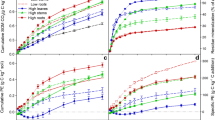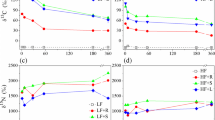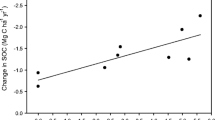Abstract
Background and aims
Crop residues and soil types play an important role in soil C and N storage. The objectives of this study were to quantify the effects of crop residue quality and interactions with soil type on soil C and N, in the short- and medium-term, and to determine the responses related to the priming effect (PE).
Methods
Residues of vetch (Vicia sativa L.), pea (Pisum sativum L.) and wheat (Triticum aestivum L.) crops with different chemical compositions and labelled with 13C and 15N were left to decompose on the surface of either a sandy-loam soil or a clay soil incubated under laboratory conditions at 25 °C for 360 days. We measured the total CO2-C and CO2-13C emitted during decomposition, the soil mineral N content and the amounts of 13C and 15N remaining in both the surface residue particles and the bulk soil.
Results
Over the short-term, the vetch residues decomposed faster than those of wheat and pea on the soil surface due to their more favourable chemical composition for biodegradation; after one year, however, this difference disappeared. We observed extra soil C mineralization in all cases, i.e., the PE was positive for all treatments and was directly related to the water-soluble (vetch > pea > wheat) and soil C contents (clay soil > sandy-loam soil). Conversely, the fate of the added 15N and net N mineralization differed considerably between the three residues and was strongly related to the initial N content of the residue.
Conclusions
Crop residue quality and soil type affected the soil PE and soil C balance but not the fate of crop residue-C after one year. Net soil N mineralization was observed in all crop residues, with large early differences (vetch > pea > wheat), which were maintained on a medium-term basis. Our results emphasize the need to jointly consider C and N dynamics as well as short- and medium-term effects to manage agricultural and environmental services provided by the recycling of crop residues to agricultural soils.




Similar content being viewed by others
References
Abiven S, Recous S, Reyes V, Oliver R (2005) Mineralisation of C and N from root, stem and leaf residues in soil and role of their biochemical quality. Biol Fertil Soils 42:119–128. doi:10.1007/s00374-005-0006-0
Baer SG, Meyer CK, Bach EM, Klopf RP, Six J (2010) Contrasting ecosystem recovery on two soil textures: implications for carbon mitigation and grassland conservation. Ecosphere 1:1–22. doi:10.1890/ES10-00004.1
Bird JA, Kleber M, Torn MS (2008) 13C-and 15N stabilization dynamics in soil organic matter fractions during needle and fine root decomposition. Org Geochem 39:465–477. doi:10.1016/j.orggeochem.2007.12.003
Blagodatskaya Е, Kuzyakov Y (2008) Mechanisms of real and apparent priming effects and their dependence on soil microbial biomass and community structure: critical review. Biol Fertil Soils 45:115–131. doi:10.1007/s00374-008-0334-y
Blagodatsky S, Blagodatskaya E, Yuyukina T, Kuzyakov Y (2010) Model of apparent and real priming effects: linking microbial activity with soil organic matter decomposition. Soil Biol Biochem 42:1275–1283. doi:10.1016/j.soilbio.2010.04.005
Brooks PD, Stark JM, McInteer BB, Preston T (1989) Diffusion method to prepare soil extracts for automated nitrogen-15 analysis. Soil Sci Soc Am J 53:1707–1711. doi:10.2136/sssaj1989.03615995005300060016x
Castellano MJ, Mueller KE, Olk DC, Sawyer JE, Six J (2015) Integrating plant litter quality, soil organic matter stabilization, and the carbon saturation concept. Glob Change Biol 21:3200–3209. doi:10.1111/gcb.12982
Cobo JG, Barrios E, Kass DCL, Thomas RJ (2002) Decomposition and nutrient release by green manures in tropical hillside agroecosystem. Plant Soil 240:331–342. doi:10.1023/A:1015720324392
Coppens F, Garnier P, Findeling A, Merckx R, Recous S (2007) Decomposition of mulched versus incorporated crop residues: modelling with PASTIS clarifies interactions between residue quality and location. Soil Biol Biochem 39:2339–2350. doi:10.1016/j.soilbio.2007.04.005
Cotrufo MF, Wallenstein MD, Boot CM, Denef K, Paul E (2013) The microbial efficiency-matrix stabilization (MEMS) framework integrates plant litter decomposition with soil organic matter stabilization: do labile plant inputs form stable soil organic matter? Glob Change Biol 19:988–995. doi:10.1111/gcb.12113
Cotrufo MF, Soong JL, Horton AJ, Campbell EE, Haddix M, Wall DH, Parton WJ (2015) Formation of soil organic matter via biochemical and physical pathways of litter mass loss. Nat Geosci 8:776–779. doi:10.1038/ngeo2520
de Bruijn AMG, Butterbach-Bahl K (2010) Linking carbon and nitrogen mineralization with microbial responses to substrate availability—the DECONIT model. Plant Soil 328:271–290. doi:10.1007/s11104-009-0108-9
de Oliveira FA, Amado TJC, da Silveira NR, de Moraes Sá JC, Fiorin JE, Hansel DS, Menefee D (2013) Soil carbon stratification affected by long-term tillage and cropping systems in southern Brazil. Soil Tillage Res 133:65–74. doi:10.1016/j.still.2013.05.011
Dungait JAJ, Hopkins DW, Gregory AS, Whitmore AP (2012) Soil organic matter turnover is governed by accessibility not recalcitrance. Glob Change Biol 18:1781–1796. doi:10.1111/j.1365-2486.2012.02665.x
Finn D, Page K, Catton K, Strounina E, Kienzle M, Robertson F, Armstrong R, Dalal R (2015) Effect of added nitrogen on plant litter decomposition depends on initial soil carbon and nitrogen stoichiometry. Soil Biol Biochem 91:160–168. doi:10.1016/j.soilbio.2015.09.001
Fontaine S, Mariotti A, Abbadie L (2003) The priming effect of organic matter: a question of microbial competition? Soil Biol Biochem 35:837–843. doi:10.1016/S0038-0717(03)00123-8
Fontaine S, Bardoux G, Abbadie L, Mariotti A (2004) Carbon input to soil may decrease soil carbon content. Ecol Lett 7:314–320. doi:10.1111/j.1461-0248.2004.00579.x
Fontaine S, Henault C, Aamor A, Bdioui N, Bloor JMG, Maire V, Mary B, Revaillot S, Maron PA (2011) Fungi mediate long term sequestration of carbon and nitrogen in soil through their priming effect. Soil Biol Biochem 43:86–96. doi:10.1016/j.soilbio.2010.09.017
Frey SD, Elliott ET, Paustian K, Peterson GA (2000) Fungal translocation as a mechanism for soil nitrogen inputs to surface residue decomposition in a no-tillage agroecosystem. Soil Biol Biochem 32:689–698. doi:10.1016/S0038-0717(99)00205-9
Frøseth RB, Bleken MA (2015) Effect of low temperature and soil type on the decomposition rate of soil organic carbon and clover leaves, and related priming effect. Soil Biol Biochem 80:156–166. doi:10.1016/j.soilbio.2014.10.004
Gentile R, Vanlauwe B, Kavoo A, Chivenge P, Six J (2010) Residue quality and N fertilizer do not influence aggregate stabilization of C and N in two tropical soils with contrasting texture. Nutr Cycl Agroecosystems 88:121–131. doi:10.1007/s10705-008-9216-9
Gentile R, Vanlauwe B, Six J (2011) Litter quality impacts short- but not long-term soil carbon dynamics in soil aggregate fractions. Ecol Appl 21:695–703. doi:10.1890/09-2325.1
Guenet B, Neill C, Bardoux G, Abbadie L (2010) Is there a linear relationship between priming effect intensity and the amount of organic matter input? Appl Soil Ecol 46:436–442. doi:10.1016/j.apsoil.2010.09.006
Hoosbeek MR, Scarascia-Mugnozza GE (2009) Increased litter build up and soil organic matter stabilization in a poplar plantation after 6 years of atmospheric CO2 enrichment (FACE): final results of POP-EuroFACE compared to other forest FACE experiments. Ecosystems 12:220–239. doi:10.1007/s10021-008-9219-z
Hoosbeek MR, Lukac M, van Dam D, Godbold DL, Velthorst EJ, Biondi FA, Peressotti A, Cotrufo MF, de Angelis P, Scarascia-Mugnozza G (2004) More new carbon in the mineral soil of a poplar plantation under free air carbon enrichment (POPFACE): cause of increased priming effect? Glob Biogeochem Cycles 18:1–7
Jensen LS, Salo T, Palmason F, Breland TA, Henriksen TM, Stenberg B, Pedersen A, Lundström C, Esala M (2005) Influence of biochemical quality on C and N mineralisation from a broad variety of plant materials in soil. Plant Soil 273:307–326. doi:10.1007/s11104-004-8128-y
Keeney DR, Nelson DW (1982) Nitrogen in organic forms. In: Page AL (ed) Methods of soil analysis: part 2. Chemical and microbiological, 2nd edn. American Society of Agronomy, Madison, WI, pp 643–698
Kögel-Knabner I, Guggenberger G, Kleber M, Kandeler E, Kalbitz K, Scheu S, Eusterhues K, Leinweber P (2008) Organo-mineral associations in temperate soils: integrating biology, mineralogy, and organic matter chemistry. J Plant Nutr Soil Sci 171:61–82. doi:10.1002/jpln.200700048
Kuzyakov Y (2002) Review: factors affecting rhizosphere priming effects. J Plant Nutr Soil Sci 165:382–396. doi:10.1002/1522-2624(200208)165:4<382::AID-JPLN382>3.0.CO;2-#
Kuzyakov Y (2010) Priming effects: interactions between living and dead organic matter. Soil Biol Biochem 42:1363–1371. doi:10.1016/j.soilbio.2010.04.003
Manzoni S, Trofymow JA, Jackson RB, Porporato A (2010) Stoichiometric controls on carbon, nitrogen, and phosphorus dynamics in decomposing litter. Ecol Monogr 80:89–106. doi:10.1890/09-0179.1
Martens D (2000) Plant residue biochemistry regulates soil carbon cycling and carbon sequestration. Soil Biol Biochem 32:361–369. doi:10.1016/S0038-0717(99)00162-5
Paterson E, Sim A (2013) Soil-specific response functions of organic matter mineralization to the availability of labile carbon. Glob Change Biol 19:1562–1571. doi:10.1111/gcb.12140
Plante AF, Parton WJ (2007) The dynamics of soil organic matter and nutrient cycling. In: Paul EA (ed) Soil microbiology, ecology, and biochemistry, 3rd edn. Academic Press, Amsterdam, pp. 433–464
Qiao NA, Schaefer D, Blagodatskaya E, Zou X, Xu X, Kuzyakov Y (2014) Labile carbon retention compensates for CO2 released by priming in forest soils. Glob Change Biol 20:1943–1954. doi:10.1111/gcb.12458
Rasmussen C, Southard RJ, Horwath WR (2008) Litter type and soil minerals control temperate forest soil carbon response to climate change. Glob Change Biol 14:2064–2080. doi:10.1111/j.1365-2486.2008.01639.x
Rasse DP, Rumpel C, Dignac M (2005) Is soil carbon mostly root carbon? Mechanisms for a specific stabilisation. Plant Soil 269:341–356. doi:10.1007/s11104-004-0907-y
Recous S, Robin D, Darwis D, Mary B (1995) Soil inorganic N availability: effect on maize residue decomposition. Soil Biol Biochem 27:1529–1538. doi:10.1016/0038-0717(95)00096-W
Redin M, Guénon R, Recous S, Schmatz R, de Freitas LL, Aita C, Giacomini SJ (2014) Carbon mineralization in soil of roots from twenty crop species, as affected by their chemical composition and botanical family. Plant Soil 378:205–214. doi:10.1007/s11104-013-2021-5
Roychand P, Marschner P (2013) Respiration in a sand amended with clay – effect of residue type and rate. Eur J Soil Biol 58:19–23. doi:10.1016/j.ejsobi.2013.05.005
Rubino M, Dungait JAJ, Evershed RP, Bertolini T, De Angelis P, D’Onofrio A, Lagomarsino A, Lubritto C, Merola A, Terrasi F‘A (2010) Carbon input belowground is the major C flux contributing to leaf litter mass loss: evidences from a 13C labelled-leaf litter experiment. Soil Biol Biochem 42:1009–1016. doi:10.1016/j.soilbio.2010.02.018
Scott NA, Cole CV, Elliott ET, Huffman SA (1996) Soil textural control on decomposition and soil organic matter dynamics. Soil Sci Soc Am J 60:1102–1109. doi:10.2136/sssaj1996.03615995006000040020x
Soil Survey Staff (2010) Keys to soil taxonomy, 11th edn. USDA Natural Resources Conservation Service, Washington, DC
Sollins P, Swanston C, Kramer M (2007) Stabilization and destabilization of soil organic matter - a new focus. Biogeochemistry 85:1–7. doi:10.1007/s10533-007-9099-x
Stevenson FJ (1994) Humus chemistry: genesis, composition, reactions, 2nd edn. John Wiley and Sons, New York, 1994
Tahir MM, Recous S, Aita C, Pilecco GE, Schmatz R, Giacomini SJ (2016) In situ roots decompose faster than shoots left on the soil surface under subtropical no-till conditions. Biol Fert Soils 52:853–865. doi:10.1007/s00374-016-1125-5
Thippayarugs S, Toomsan B, Vityakon P, Limpinuntana V, Patanothai A, Cadisch G (2008) Interactions in decomposition and N mineralization between tropical legume residue components. Agroforest Syst 72:137–148. doi:10.1007/s10457-007-9062-9
Tribouillois H, Cruz P, Cohan J, Justes É (2015) Modelling agroecosystem nitrogen functions provided by cover crop species in bispecific mixtures using functional traits and environmental factors. Agric Ecosyst Environ 207:218–228. doi:10.1016/j.agee.2015.04.016
Trinsoutrot I, Recous S, Bentz B, Linères M, Chèneby D, Nicolardot B (2000) Biochemical quality of crop residues and carbon and nitrogen mineralization kinetics under non limiting nitrogen conditions. Soil Sci Soc Am J 64:918–926. doi:10.2136/sssaj2000.643918x
Wang WJ, Baldock JA, Dalal RC, Moody PW (2004) Decomposition dynamics of plant materials in relation to nitrogen availability and biochemistry determined by NMR and wet-chemical analysis. Soil Biol Biochem 36:2045–2058. doi:10.1016/j.soilbio.2004.05.023
Wang H, Boutton TW, Xu W, Hu G, Jiang P, Bai E (2015) Quality of fresh organic matter affects priming of soil organic matter and substrate utilization patterns of microbes. Sci Rep 5:10102. doi:10.1038/srep10102
Acknowledgements
This work was supported by the Brazilian government through the Conselho Nacional de Desenvolvimento Científico e Tecnológico (CNPq). The bilateral Brazilian and French collaboration was funded under Program CNPq—Ciência sem Fronteiras, Process Number 207530/2015-7, and by INRA (the Environment & Agronomy Division) during Schmatz’s leave at UMR FARE in Reims, France.
Author information
Authors and Affiliations
Corresponding author
Additional information
Responsible Editor: Elizabeth M Baggs.
Rights and permissions
About this article
Cite this article
Schmatz, R., Recous, S., Aita, C. et al. Crop residue quality and soil type influence the priming effect but not the fate of crop residue C. Plant Soil 414, 229–245 (2017). https://doi.org/10.1007/s11104-016-3120-x
Received:
Accepted:
Published:
Issue Date:
DOI: https://doi.org/10.1007/s11104-016-3120-x




